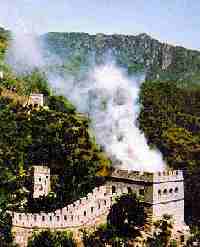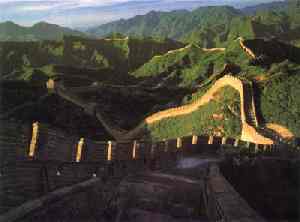 To the northwest and north of Beijing, a huge, serrated wall zigzags
its way to the east and west along the undulating mountains. This is
the Great Wall, which is said to be visible from the moon/outer space.
After Tần Thủy Hoàng unified China in 221 B.C., the walls were built to prevent
the invaders from the Xiongnu tribes in the north. They were extended
to more than 10,000 li or 5,000 kilometers which originated the name
"10,000-li Great Wall".
To the northwest and north of Beijing, a huge, serrated wall zigzags
its way to the east and west along the undulating mountains. This is
the Great Wall, which is said to be visible from the moon/outer space.
After Tần Thủy Hoàng unified China in 221 B.C., the walls were built to prevent
the invaders from the Xiongnu tribes in the north. They were extended
to more than 10,000 li or 5,000 kilometers which originated the name
"10,000-li Great Wall".
The Great Wall was renovated from time to time after the Qin Dynasty.
A major renovation started with the founding of the Ming Dynasty in
1368, and took 200 years to complete. The wall we see today is almost
exactly the result of this effort. With a total length of over
6,000 kilometers, it extends to the jiayu Pass in Gansu Province in
the west and to the mouth of the Yalu River in Liaoning Province in
the east.
Important sections of the Wall:
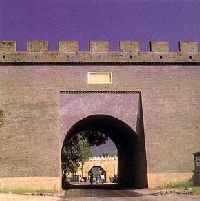 Located 10 kilometers south of the Badaling section of the Great Wall
and built
Located 10 kilometers south of the Badaling section of the Great Wall
and built 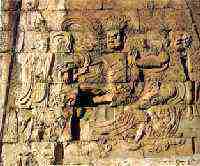 in an 18.5-kilometer-long valley, the pass has always been
an important gateway northwest of Beijing.
Cloud Terrace, built in 1345, was
originally the base of a pagoda over looking the main road of the
town of the pass. The arched gate of the terrace and the walls inside
the arch are decorated with carvings. of elephants, lions, birds,
flowers and heavenly kings as well as charms in six languages-Sanskrit,
Tibetan, Phats pa (Mongolian), Uygur, West Xia and Han.
in an 18.5-kilometer-long valley, the pass has always been
an important gateway northwest of Beijing.
Cloud Terrace, built in 1345, was
originally the base of a pagoda over looking the main road of the
town of the pass. The arched gate of the terrace and the walls inside
the arch are decorated with carvings. of elephants, lions, birds,
flowers and heavenly kings as well as charms in six languages-Sanskrit,
Tibetan, Phats pa (Mongolian), Uygur, West Xia and Han.
The Mutianyu section covers 70 kilometers northeast of
Beijing. This is one of the best sections of the Great Wall, linking
the Gubeikou and Badaling sections, from East to West, respectively.
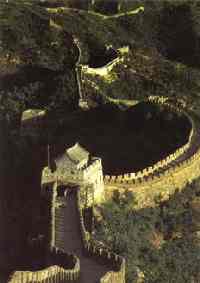
The battles in the Jinshanling division are
built along the ridge of a mountain, where the soldiers can defeat
the enemy by taking advantage of the high terrain.
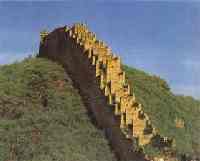
Located to the east of Jinshanling, the Simatai division is 3,000 metres long and has 35 battle forts. The wall rises and
falls with the precipitous mountain ridge while the battle forts are
located high up the hills.
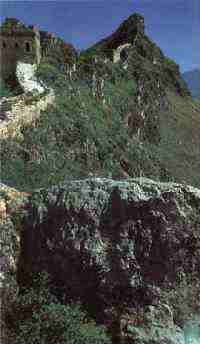
The Beacon Tower: Alarm was raised by smoke signals and by fire at night. Smoke
was produced by burning a mixture of wolf dung, sulfur and saltpeter.
The alarm could be relayed over
500km within just a few hours.
